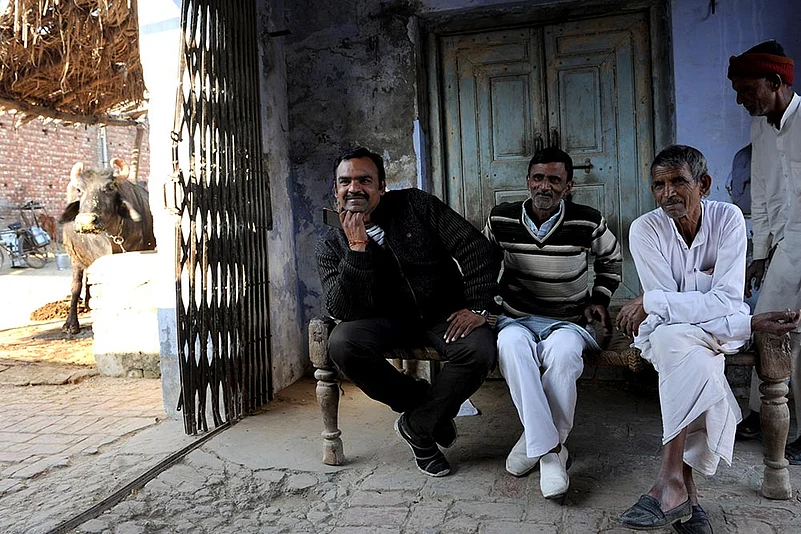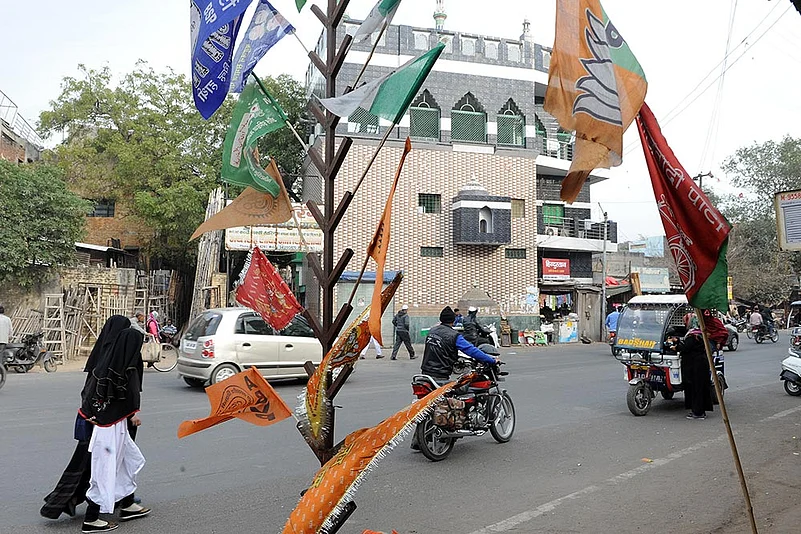Uttar Pradesh Assembly Poll 2017
324 ⁄ 403
- OBCs, nearly 40 per cent of UP's population, rallied behind BJP
- BJP’s middle class support was intact, making room for policies targeting rural voters
***
In 2014, the BJP drove into Uttar Pradesh, riding on two wheels—one was the promise of development, and the other was assertion of Hindutva. Four years on, amidst widespread chatter about early and combined national and state polls, Hindutva continues to hold voters in thrall, but the wheel of development is coming unstuck. This is apparent from travels through Saharanpur and Muzaffarnagar, two districts in the western part of the electorally vital state where voter sentiment is verging on disenchantment. This is especially true of the various “backward” communities whom the BJP had stitched together as a “non-Yadav” electoral grouping in the run-up to the previous general election.
The road to Lucknow is said to run through western UP, which set the tone for BJP victories in the 2014 polls, leading to the formation of the Narendra Modi government at the Centre, as well as the 2016 assembly polls, which made Yogi Adityanath the CM. The NDA’s score of 73 of 80 Lok Sabha seats in UP and an equally impressive assembly win owed much to this primarily agrarian belt, which has only a smattering of industry and a powerful trading community. In these parts, sections of the OBCs and many Dalits had joined the BJP’s dominant-caste votebank, decisively tilting the scales. Now, these alliances are facing the test of promises fulfilled or broken, though it is still hard to tell which of the two—Hindutva or development—will win the race.
The people in this region address their hopes and concerns directly to “Modi-Yogi”, a marker of their perceived personal connect with voters—in fact, not just did the PM campaign here, but the people also expect him to solve problems that the state government is supposed to handle. “We are with Modi-Yogi, but some work should get done,” says Urmila, who lives in Manoharpur, a village within Saharanpur city, while Sheela adds, “Modi came, but we did not benefit. Taxes are higher and the ban on sand-mining squeezed our income.” Urmila and Sheela belong to the Saini community, one of the state’s numerous “non-Yadav backward” groups that the BJP actively wooed in 2014.
About an hour’s drive from Manoharpur, in Kutba Mazra, Sushil, a farm labourer from the Kumhar caste (traditionally potters), complains that his monthly “Samajwadi pension” of Rs 500, started by Akhilesh Yadav’s government, has stopped. “Even as people are going all ‘Modi-Yogi’, we got nothing,” says Sudesh Prajapati, Sushil’s neighbour, whose husband sells momos for a living. “Modi said he will remove poverty, that women will be trained to roll agarbattis at home, but nothing happened. He, too, is helping only the rich.”
Sudesh describes her family as “Modi bhakts” who believe a government building roads and toilets—plus a Ram Temple in Ayodhya—will earn worldwide acclaim. “We may have voted for pooja-path (the road of worship), but even ghee and earthen lamps cost money,” Sushil says.
Saharanpur’s rich and poor have been promised different sets of gains, so to speak. While farmers, workers and others lower down the social hierarchy aspire for prosperity, “self-respect” and “national pride” oil the wheels of the urban middle class, professionals and rich farmers with enough clout to set mainstream narratives. “People are in no mood for change,” says Deepak Maheswari, a well-off farmer in Mohanpur Gada, 20 km from Mazra. “They believe the coffers were empty when BJP took charge, but once they fill up again, they hope to get something.”
Meanwhile, the latest bumper crop of sugarcane has raised a spectre of unpaid dues by sugar mills. The anger of dominant Rajput and Jat farmers looms on the horizon, while Muslims are increasingly hemmed in by an expanding communal discourse. And, while many Dalits had supported the BJP in 2014, the state’s crackdown on them in Shabbirpur last year has fuelled resentment and rage against the ruling party. The Dalits of Shabbirpur accuse the Thakurs of burning over 50 of their homes in what was widely called “Dalit-Rajput clashes”.

Deepak Maheswari (left), a well-off farmer in Saharanpur district
“At least Modi as head of government is not corrupt and Yogi has wiped out crime,” says Premchand Sharma, an advocate in Saharanpur city who supports the BJP. “There is something different about Modi—that’s why America is behind India. He is the only one who can solve the Palestine crisis.” There are many like Sharma among the dominant-caste farmers, professionals and traders in Saharanpur and Muzaffarnagar, who say they had expected more ‘Hindutva’ and support demands for a “population-control policy”, including a two-child norm, a uniform civil code and the revocation of reservation in jobs. “Cows are being slaughtered less, but the loudspeakers (of mosques) are yet to fall silent,” says Vipin Sharma, a trader at Muzaffarnagar’s Dal Mandi. “For the sake of the country, our vote will always be for the BJP.”
“It is because of Muslims that we vote for the BJP, so they can save Hindus from Muslims. If the Samajwadi Party wins, we feel more pressure from Muslims,” says another trader, Ashutosh Singhal, who, however, wishes the BJP government would also scrap the policy of affirmative discrimination based on caste identity.
Despite these traders’ pro-BJP views, it was the Congress that won local elections in Muzaffarnagar for the second time in a row recently. “Modi showed us big dreams, but finished off the small customers,” says Sanjay Sharma, a cloth trader in Muzaffarnagar. “They said they would provide jobs, but I don’t have enough work to employ 10, so I have only five employees. Even dal is more expensive. So, next time, let it be a Congress government.”
Meanwhile, the talk of ending reservation is pushing more Dalits to Mayawati’s BSP, even as many Muslims, too, are considering that option. “We picked the PM, but when he talks about selling pakodas, we feel ashamed,” says Arvind, a resident of the Ravidass Hostel in Saharanpur from where the Bhim Army led by Chandrashekhar Azad launched its campaign against caste-based atrocities and Thakur/Rajput domination last May. Chandrashekhar is currently being held in Saharanpur jail under the National Security Act (NSA), which was slapped after the Allahabad High Court granted him bail in November 2017 on finding all charges against him and his associates to be “politically motivated”.
“The biggest success of Modi and the BJP was in pulling all Hindus into its camp. Yet we are targeted during our celebrations,” says Arvind, who did not want to be identified. The embers of Shabbirpur, it seems, are yet to die. In Mohanpur Gada in Saharanpur, the recent Padmaavat protests by Rajputs in neighbouring villages were a nightmare for both Pasmanda Muslims and Jatavs. “The Rajputs don’t even let us sit next to them. With the Muslims, on the other hand, we are safe and happy,” says Ram Singh, a daily wage worker and a Chamar (traditionally leather workers) by caste. “Let Mayawati come to power. She has promised a lot and will fulfil them.”
There is indeed a strong anti-BJP sentiment among the Dalits in Shabbirpur. Pushpendra, a young Jatav, was attracted to the BJP in 2011 when it took young boys to hoist the national flag at Srinagar’s Lal Chowk, but was stopped at Pathankot. “The talk was of revoking Article 370 (of the Indian Constitution). We had also heard about Gujarat’s development. In the next elections, though, we will bring in the Congress,” he says. Across the region, the older Dalits remain supporters of Mayawati and are ready to wait “indefinitely” for her return to power. “After the Muzaffarnagar riots, people gave Modi and the BJP a chance, but when we had to run for our lives in our own village, we changed our minds,” says Sudesh (not Prajapati), whose brother, former Shabbirpur pradhan Shiv Kumar, is in jail with Chandrashekhar.
In contrast, the Thakurs of Shabbirpur are mostly supporters of the Yogi government. “They (Dalits) tried to take out another yatra on January 29, but we didn’t let them,” says Ankit, a Rajput resident of Ambehta Chand, close to Shabbirpur. “Ab toh hamaari hi niklegi yatra, Rana Pratap ki, April-May mein (The next procession here will be ours—to commemorate Rana Pratap).” Three of Ankit’s “Rajput brothers” are among those arrested last May. “Yogi is a Rajput and yet he got Rajputs arrested,” says Ankit, looking angry. That’s not the defining sentiment among his caste fellows. As Surender, a sugarcane farmer, puts it: “Everything may not be fine with this government, but we have never voted for anybody else.”
The 900-plus police encounters since Yogi became CM have established the government’s reputation as a “crime fighter”, a big plus in the BJP’s larger kitty. “What we don’t understand is why reservation is not being done away with. A majority in the Rajya Sabha will perhaps make a big difference,” says Rajkumar, a Rajput and pradhan of Sona Arjunpur.
On reservation, the BJP may have other plans. A quota within the OBC quota to address lack of employment opportunities for the relatively worse-off OBC groups is in the works. This would consolidate support for ‘Modi-Yogi’ among the rural poor, though possibly at the cost of some urban support. According to a Samajwadi Party leader, they plan to “conditionally” support this plan—as long as the quotas are proportional to the population of each group within the OBC category and a creamy layer is clearly identified. Among the Gujjars, who are numerically strong in Saharanpur, Modi’s reputation is intact, though he generates less enthusiasm now. “The government promised to double farm incomes, but it hasn’t happened. Otherwise we are SP supporters,” says Tejpal, an elderly Gujjar farmer.
And then there is the steady closure of mining, construction, paper and metal-and-wood works industries, which has created a permanent discontent against every political party. But who turns the resentment into votes is what much of politics is all about. Even when the Rashtriya Lok Dal was at its lowest ebb, for instance, the Jats continued to vote for it. That’s what they are expected to do for other parties, too, including the BJP. In this region, the Hindutva narrative has captured the imagination not just of the Jats (where in the villages a murmur or two of discontent can be heard), but also of several other OBCs, such as the Pals. Adesh Kumar, a policeman of the Pal caste from Bagra village in Muzaffarnagar, says his grouse is border skirmishes with Pakistan. “All-out war would be best, perhaps,” he says.
Similarly, in Sandhawali, despite grave concerns over the lack of development, the people are happiest about the crackdown on cow slaughter. “It’s good for the country that the Qureishis can’t slaughter cows anymore,” says Mayank Singh Pal, who has been trying to find work. Jai Singh Kashyap, a vegetable seller, says GST, demonetisation and factory closures have affected the young, but rates the Ayodhya temple as an equally important issue. “It was Akhilesh Yadav who created conditions for factory closures,” says Bhagat, another resident.
There is some discomfort around that the Opposition has to mine for votes—provided they can find enough muscle to hit the trenches. After the Muzaffarnagar riots in 2013, the Jats went into the BJP fold, where the Gujjars cannot follow. The Congress can stitch together such disparate groups, but needs to be part of an alliance. If the Opposition join forces—which they have, in secret, and are thrashing out Lok Sabha seats—they stand to gain, provided the Hindu-Muslim chasm doesn’t open the trapdoor under their feet.
By Pragya Singh in Western UP
















